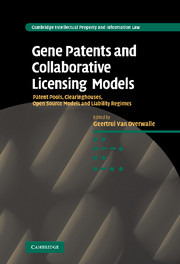 Gene Patents and Collaborative Licensing Models
Gene Patents and Collaborative Licensing Models Book contents
- Frontmatter
- Contents
- List of contributors
- Preface
- Foreword: Jean-Jacques Cassiman
- List of abbreviations
- Part I Patent pools
- 1 Patent pooling for gene-based diagnostic testing. Conceptual framework
- 2 Case 1. The MPEG LA® Licensing Model. What problem does it solve in biopharma and genetics?
- 3 Case 2. The SARS case. IP fragmentation and patent pools
- 4 Critical analysis of patent pools
- Part II Clearinghouses
- Part III Open source models
- Part IV Liability regimes
- Part V Different perspectives
- Part VI Summary and concluding analysis
- Index
- Titles in the series
2 - Case 1. The MPEG LA® Licensing Model. What problem does it solve in biopharma and genetics?
from Part I - Patent pools
Published online by Cambridge University Press: 14 January 2010
- Frontmatter
- Contents
- List of contributors
- Preface
- Foreword: Jean-Jacques Cassiman
- List of abbreviations
- Part I Patent pools
- 1 Patent pooling for gene-based diagnostic testing. Conceptual framework
- 2 Case 1. The MPEG LA® Licensing Model. What problem does it solve in biopharma and genetics?
- 3 Case 2. The SARS case. IP fragmentation and patent pools
- 4 Critical analysis of patent pools
- Part II Clearinghouses
- Part III Open source models
- Part IV Liability regimes
- Part V Different perspectives
- Part VI Summary and concluding analysis
- Index
- Titles in the series
Summary
Introduction
Consumer electronics, telecommunications, computer and related industries have successfully employed a patent licensing model that encourages innovation through marketplace competition by balancing patent holders' expectation of reasonable return on their intellectual property (IP) with marketplace desire for widespread availability of technology. The model pioneered by MPEG LA offers fair, reasonable, non-discriminatory access to essential IP from multiple patent holders under a single license as an alternative to separate licenses. The MPEG LA® Licensing Model has worked well where it solved a problem. But, what problem does it solve in biopharma and genetics?
Background
A patent is the grant of a property right covering an invention. The right conferred by the patent gives its owner the right to exclude others from making, using, offering for sale, selling or importing the invention in the absence of a license. Where standards and other technology platforms consist of many patents owned by many patent owners, the number of licenses required of users may be too costly and inefficient for users to negotiate. This is often referred to as a patent thicket. By increasing uncertainty and conflict and restricting freedom of movement surrounding use of a technology, a patent thicket may impede its adoption, interoperability and use.
In the 1990s the MPEG-2 standard, which is required for DVD, satellite, cable and other digital video applications, faced a patent thicket. The single biggest challenge to MPEG-2 adoption was access to essential patents.
- Type
- Chapter
- Information
- Gene Patents and Collaborative Licensing ModelsPatent Pools, Clearinghouses, Open Source Models and Liability Regimes, pp. 33 - 41Publisher: Cambridge University PressPrint publication year: 2009
- 1
- Cited by


